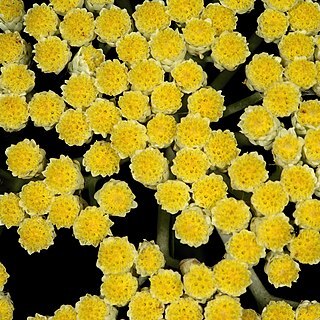Perennial herb; flowering stem up to 0.65 m high, usually solitary, leafy in lower half, becoming pedunculoid upwards, thinly woolly; crown not woolly. Leaves: blade of basal leaves broadly to narrowly elliptic, up to 400 x 120 mm, contracted to long, flat petiole-like base, expanded and clasping, apex acute to acuminate, margins often undulate, upper surface harshly pubescent, lower surface thinly greyish white-felted, 5-7-nerved, tertiary veins scalariform; stem leaves similar, sessile, cordate-clasping. Heads discoid, campanulate, ± 6-7 x 6-7 mm, many in compact, flat-topped corymb. Involucral bracts in ± 4 series, subequal, closely imbricate, equalling florets, backs woolly, tips ovate, subobtuse, creamy to pale yellow, sometimes washed palest brown, scarcely radiating, stereome divided. Receptacle epaleate, with fimbrils ± equalling ovaries. Flowers: disc florets only, 18-34; corolla campanulate above, white to pale yellow; Nov.-Jan. Fruit with cypsela? (and ovary) glabrous. Pappus of many barbellate bristles, bases lightly fused.
Rootstock stout, woody, flowering stem solitary, up to 650 mm high, thinly woolly. Leaves: radical leaves up to 400 x 120 mm, blade elliptic, contracted to a long, flat petiole-like base, expanded and clasping below, margins often undulate, upper surface harshly pubescent, lower surface greyish white-felted, 5-7-nerved, tertiary nerves clearly visible; cauline leaves similar, becoming sessile and cordate-clasping upwards, passing into distant bracts. Capitula campanulate, ± 6-7 mm long, many in a compact, flat-topped corymb; involucral bracts in ± 4 series, backs woolly, apex creamy to pale yellow or pale brown, ± opaque. Flowers 18-34. Flowering time Aug.-Feb. Pappus of many bristles, bases lightly fused.
Perennial herb, up to 0.65 m high. Radical leaves up to 400 x 120 mm, broadly to narrowly elliptic, contracted to long, flat petiole-like base, margins often undulate, upper surface harshly pubescent, lower thinly greyish white-felted; cauline leaves similar, sessile, cordate-clasping. Heads campanulate, many in compact flat-topped corymb. Flowers white to pale yellow; involucral bracts creamy to pale yellow, sometimes washed palest brown; October to January and May to July.

